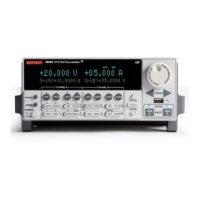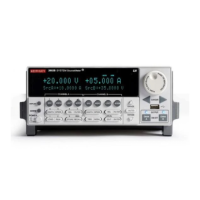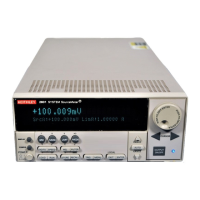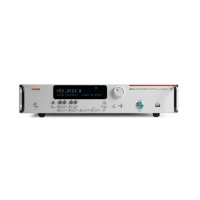2600S-901-01 Rev. C / January 2008 Return to Section Topics 11-7
Series 2600 System SourceMeter® Instruments Reference Manual Section 11: Communications Interfaces
When the SourceMeter receives a DCL command, it clears the Input Buffer and Output Queue,
cancels deferred commands, and clears any command that prevents the processing of any other
device command. A DCL does not affect instrument settings and stored data.
SDC (selective device clear)
The SDC command is an addressed command that performs essentially the same function as the
DCL command. However, since each device must be individually addressed, the SDC command
provides a method to clear only selected instruments instead of clearing all instruments
simultaneously, as is the case with DCL.
GET (group execute trigger)
GET is a GPIB trigger that is used to trigger the instrument to take readings from a remote
interface.
SPE, SPD (serial polling)
Use the serial polling sequence to obtain the SourceMeter serial poll byte. The serial poll byte
contains important information about internal functions. (See
Appendix D.) Generally, the serial
polling sequence is used by the controller to determine which of several instruments has
requested service with the SRQ line. The serial polling sequence may be performed at any time to
obtain the status byte from the SourceMeter.
Front panel GPIB operation
This section describes aspects of the front panel that are part of GPIB operation, including
messages, status indicators, and the LOCAL key.
Error and status messages
See Appendix B for a list of status and error messages associated with IEEE-488 programming.
The instrument can be programmed to generate an SRQ, and command queries can be
performed to check for specific error conditions.
GPIB status indicators
The REM (remote), TALK (talk), LSTN (listen), and SRQ (service request) annunciators show the
GPIB bus status. Each of these indicators is described below.
REM
This indicator shows when the instrument is in the remote state. When the instrument is in remote,
all front panel keys, except for the LOCAL and OUTPUT OFF keys, are locked out. When REM is
turned off, the instrument is in the local state, and front panel operation is restored.
TALK
This indicator is on when the instrument is in the talker active state. Place the unit in the talk state
by addressing it to talk with the correct talk command. TALK is off when the unit is in the talker idle
state. Place the unit in the talker idle state by sending a UNT (Untalk) command, addressing it to
listen, or sending the IFC (Interface Clear) command.
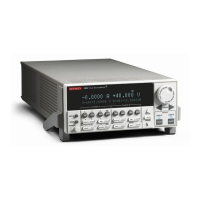
